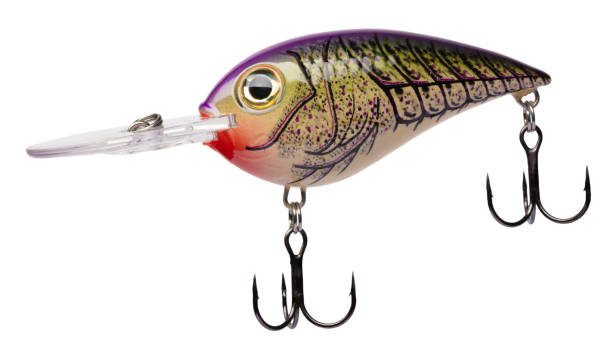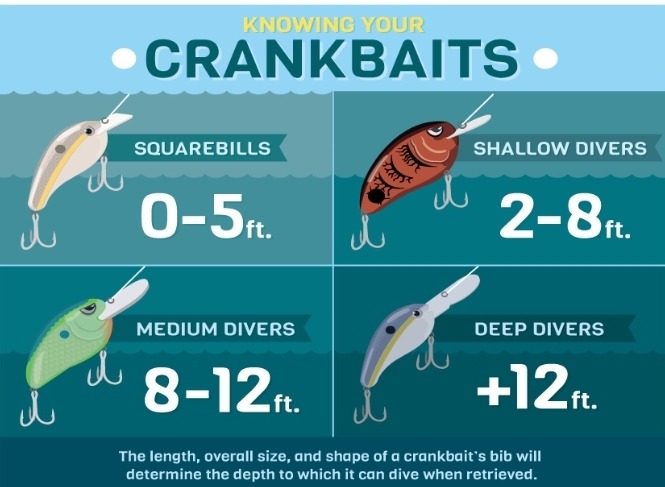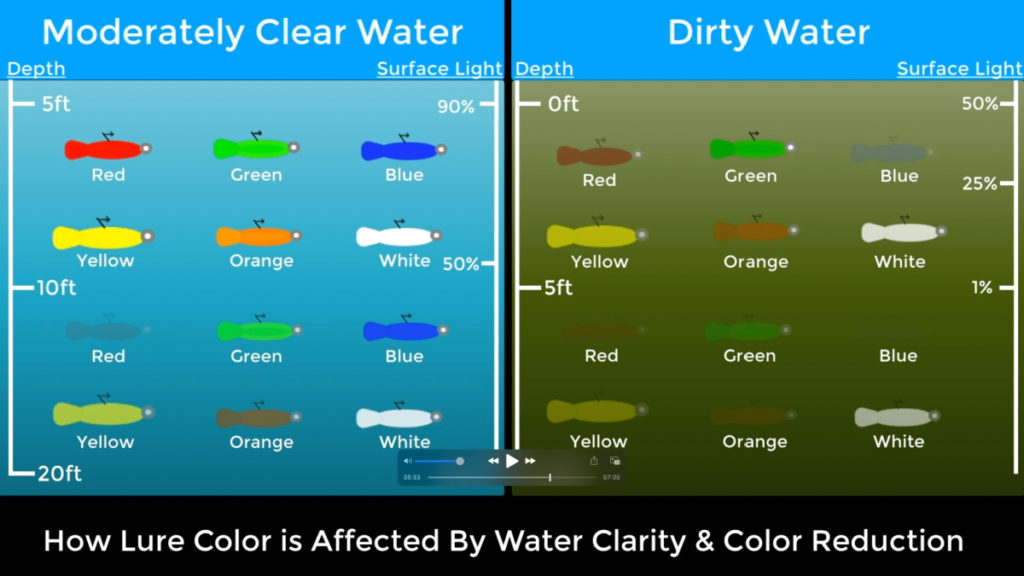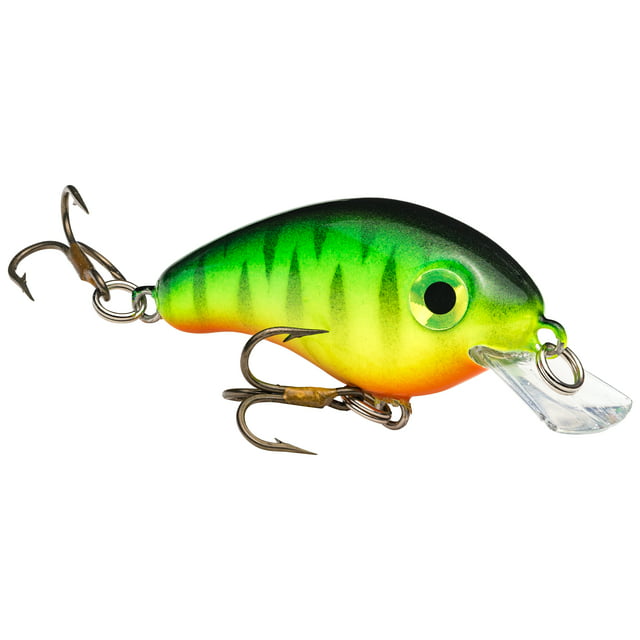There are a couple of tips that I provide to fellow anglers that are included in this article but what I don’t mention is the inevitable close encounters with a treble hook that is located on the bottom and the tail-end of a Crankbait, but if you use a crankbait for bass you have to rig it properly so that it moves how it was engineered to move. How do you Rig a Crankbait for Bass?
- Use medium-heavy rod & baitcasting reel
- Choose a quality line: monofilament or fluorocarbon.
- Tie line directly to the split ring or line tie
- Ensure hooks are sharp & positioned right
- Adjust crankbait for best performance.
- Experiment with retrieval speed & depth
- Target areas with structure/cover
- Stay patient
Crankbaits are engineered and manufactured to mimic the real-life action of a baitfish, crayfish, or most other prey that largemouth and smallmouth bass love to hunt in different depths of the water column.
Introduction:
Introducing crankbaits for bass fishing, an artful pursuit that combines technique with precision. Crankbaits are versatile lures designed to imitate the movement and appearance of prey fish, enticing bass to strike with their lifelike action. With a wide array of sizes, shapes, and colors available, anglers can tailor their approach to match the conditions and preferences of the bass they seek. Whether navigating shallow waters or probing deep structures, crankbaits offer anglers a dynamic tool to tempt bass in a variety of habitats. Through skillful presentation and strategic selection, mastering the use of crankbaits can unlock thrilling opportunities for reeling in trophy-sized bass.
How to Rig a Crankbait for Bass
If you love Bass fishing as much as I do you’ll find that rigging Crankbaits for Bass largemouth or smallmouth can heighten the fishing experience. I’ll go one better and say using a bobber rig is no competition like a Crankbait beats everything I’ve tried for excitement and sometimes even success depending.
When you fish largemouth with a fishing bait like Crankbait you need to make sure you are using all the right tackle besides the type and color of crankbait. The most important thing to remember here is no way that this way is the only way. I fish with half a dozen people and everyone has their recipe for success.
Rigging a crankbait for bass fishing involves setting up your tackle in a way that maximizes the bait’s effectiveness in attracting and catching bass. Here’s a step-by-step guide to rigging a crankbait for bass:
- Choose the Right Crankbait: Select a crankbait that suits the conditions you’ll be fishing in. Consider factors such as water depth, clarity, and the type of cover present.
-

Crankbait For Largemouth Bass Select the Appropriate Rod and Reel: For crankbait fishing, a medium-power to medium-heavy power rod with a moderate or moderate-fast action is typically preferred. Pair it with a baitcasting reel with a smooth drag system and a gear ratio suitable for crankbait retrieval (usually in the range of 5:1 to 7:1).
- Choose the Right Line: Use monofilament or fluorocarbon line for crankbait fishing. Monofilament provides buoyancy, while fluorocarbon offers better sensitivity and abrasion resistance. Avoid using a braided line, as its lack of stretch can cause the crankbait to lose its action and result in more snagging.
- Attach the Line: Tie your chosen fishing line directly to the split ring or line tie on the front of the crankbait. Use a reliable fishing knot like the Palomar knot or an improved clinch knot.
- Consider Adding a Leader: In clear water or when targeting particularly large bass, you may want to add a fluorocarbon leader between your main line and the crankbait to reduce visibility and increase abrasion resistance.
- Adjust the Hooks: Check the hooks on your crankbait. If they are dull or damaged, replace them with sharp, high-quality treble hooks. Ensure that the hooks are positioned properly to minimize snagging while still providing good hook-setting capability.
-

Chartreuse Strike king Tune the Crankbait: Some crankbaits may not run true straight out of the box. To ensure optimal performance, adjust the crankbait by bending the line tie or adjusting the eyelets slightly until it tracks straight when retrieved.
- Experiment with Depth and Speed: Vary the depth at which you fish the crankbait by adjusting your retrieval speed or using crankbaits with different diving depths. Experiment with different retrieval speeds until you find the one that triggers the most strikes.
- Be Mindful of Cover: When fishing with a crankbait, target areas with submerged vegetation, rocky structures, or other types of cover where bass are likely to be hiding. Retrieve the crankbait so that it bumps into the cover occasionally, triggering reaction strikes from nearby bass.
- Stay Patient and Persistent: Crankbait fishing for bass can be highly rewarding but may require patience and persistence to find success. Keep experimenting with different crankbaits, colors, depths, and retrieval speeds until you unlock the pattern that produces the most bites.
By following these steps and adapting to the specific conditions you encounter on the water, you can effectively rig a crankbait for bass and increase your chances of landing a trophy-worthy catch.
There are a few rules that everyone can agree on when it comes to Crankbait and Largemouth/Smallmouth Bass
- Make sure your crankbait has a snap ring on the metal eye. Most crankbaits will come with it already attached, so you shouldn’t have to buy a snap ring.
- Use your favorite knot to tie a 12-pound fluorocarbon line to the crankbait. As long as it’s a quality knot, it will work. The best fishing knots to use tieing crankbaits are a standard Clinch knot along a Non-Slip Loop Knot (Kreh Loop Knot) both knots are strong, easy to tie, & allow the crankbaits or any artificial lures to be tied directly to the lure allowing it more life-like action & presentation underwater
- Test your crankbait to ensure it’s moving straight by dropping it in the water and pulling it with your rod. If it tries to turn too much on its side, looks awkward or skips across the water. If it’s not moving through the water right, take a pair of pliers and lightly bend the metal eye connected to the snap ring in the opposite direction the lure wants to turn.
- Crankbaits are designed to maintain contact with the bottom. That’s why a long cast is crucial. The longer the cast, the more time the lure will bounce along the bottom of the water column in the strike zone, which means you’ll get more bites. A slow-speed reel works well with crankbaits because you want to reel the lure as slowly as possible while still feeling the crankbait come in contact with the bottom.
Bass Fishing Crankbait Categories
Best Crankbait Colors
What are the Types of Crankbaits?
Crankbaits are lures made in the shape of a baitfish separated into 3 types:
- Diving depth depends on size & bill shape on retrieve-shallow, medium, deep & extra deep.
- The sound produced makes sounds called “rattling”, or staying quiet called “silent”
- Lipless-Lipless-have no diving bill .………………………………………………………………………………………Read more
Lipless Crankbaits (no bill)-12 ft.+ depth slow retrieve in Spring & Fall
Lipped Crankbait (have a bill)-2 to 12 ft. Use “twitching” motion-snap lure side to side in place with a slow retrieve
Square-shaped bill Crankbait-run along bottom-through grass & weeds shallow & close to the shoreline-0-5 ft. ..………………………………..Read more
Crankbait Bass Tips
During the spring, flat-sided and lipless crawfish-colored crankbaits work best because lipless crankbaits don’t wobble as much as a billed crankbait (which looks more natural in the cooler water), and crawdads are one of the primary food sources for bass during the time of year.
In late spring and early summer, when the bass is in shallow water, a shallow diving bluegill-colored square bill crankbait works best because bluegill are public enemy number one for bass guarding beds and fry during and after the spawn.
During the hottest time of the year, bass move to deeper, cooler water. This means deep-diving shad-colored or chartreuse crankbaits are the key.
If the water is clear, go with a natural shad or baitfish color, and if the water is murky or stained, go with a bright color. Here is a list to use when using Crankbait:
Plastic vs Wood Crankbaits
What is the Best Color Crankbait?
The most important seasonal parameter for Crankbait is Color:
Spring-Crawfish red-Shad color-Chartreuse
Summer-Citrus Chad-Spooky Nasty-Homemade Shad
Fall-Go with a bone (white) color in overcast conditions
Switch to a chrome or silver color when the sun comes out.
Winter-.……………………………………………………………………………….Read more

References:
Feature Image from Karl’s Bait & Tackle
FAQ’s
How do I choose the right crankbait color? A: Selecting the best crankbait color involves considering the water clarity, light conditions, and the prevalent forage in the area. In clear water, natural baitfish colors like shad or silver are often effective, while bright colors like chartreuse work well in stained or murky water. Matching the color pattern to the local prey species such as crawfish or bluegill can also increase your chances of success.
Q: What gear should I use for crankbait fishing? A: For crankbait fishing, a medium-power to medium-heavy power rod with a moderate or moderate-fast action is typically preferred. Pair it with a baitcasting reel spooled with monofilament or fluorocarbon line. Choose a line weight and rod action that matches the size and diving depth of the crankbait you intend to use.
Q: How should I retrieve a crankbait? A: The retrieve technique for crankbaits can vary depending on the style of lure and the behavior of the bass. In general, start by casting the crankbait and allowing it to dive to the desired depth. Retrieve the lure with a steady, medium-speed retrieve, occasionally pausing or varying the speed to trigger strikes. Experiment with different retrieval speeds and pauses to determine what the bass is responding to best.




